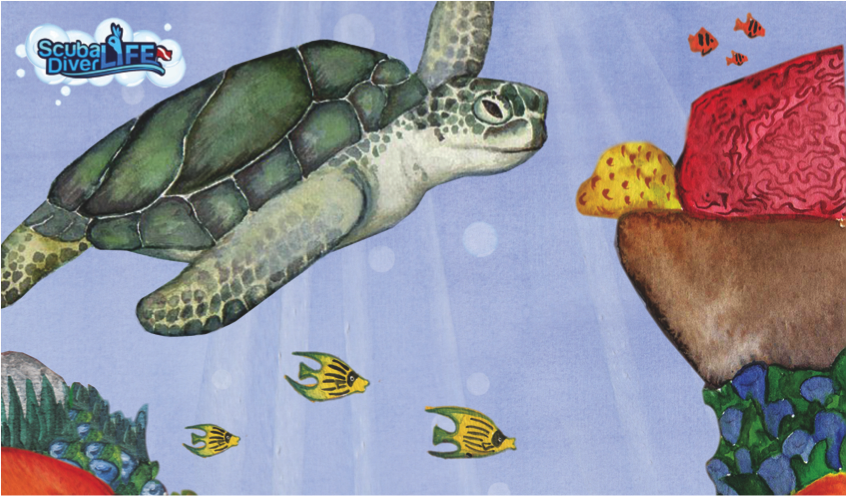It had been a long journey across the vast ocean, soaring through currents and battling predators but she had finally arrived. Riding the crisp waves in, she felt the soft sand under her flippers and began pushing herself a shore. Her heavy shell made the pushing difficult but she continued on searching cautiously for the perfect location. Once she found it she began whipping the sand away with her flippers digging a hole just wide enough. Then one by one she filled the hole with 100 glorious and precious eggs.
Before returning to the sea she carefully used her flippers to cover the eggs with sand to be warmed by the sun until ready to hatch. Leaving her eggs she went back to the sea to continue on to life a long life of adventure.
Soon the soft and leathery eggs would crack open and the beautiful baby turtles would emerge into the world to begin the long life journey of a sea turtle.
Sea turtles are amazing creatures, they can life for over 80 years and grow to weigh up to 400 hundred pounds. They are graceful and beautiful and inhabit all of the world’s oceans except the Artic. Seeing these magnificent creatures on a dive is always a treat and forever humbling.
Turtle advocacy and education
Beverly Corwin Reeves; a turtle advocate and educator, member of the Sea Turtle Restoration Project, International Sea Turtle Society, Oceana, Sea Turtle Conservancy and active member and advisor of the Colorado Ocean Coalition shares her expertize with us:
Q. What lead you to become a turtle advocate?
A. “In 1998, when I saw my first Leatherback sea turtle nesting on a beach in Costa Rica at 3 a.m., a very strong passion for these magnificent creatures was placed in my heart. Since then, there has been no turning back.”
Q. During which season of the year do turtles usually nest their eggs and how often?
A.“Turtles usually nest in the warmer months. Once the female sea turtles reach sexual maturity, it is estimated they may come ashore 3-9 times a season to nest.”
Q. Sea turtles lay eggs. Why must they come ashore to do so?
A. “The turtles dig their nests on the same beaches that they hatched from or very close to the same beach. Their eggs are soft, leathery or papery in texture. The embryos breathe air through their shells while the warmth of the sand incubates the eggs. The female turtles lumber up onto the beach and dig their nests above the high water line so that the nests won’t be washed out by the sea. The temperature of the sand around the nest determines the temperature of the nest. The nest temperature determines the gender of the sea turtle hatchlings! Warmer temperatures primarily produce females and cooler temperatures primarily produce males.
Q. How many eggs do turtles nest?
A. After the female sea turtle struggles ashore and laboriously digs her nest, she drops between 50 and 150 eggs, depending on the sea turtle species. It is a grueling process for her and she spends approximately 2 hours out of the water.”
Q. How long do turtles live?
A. “Scientists are still learning about the longevity of the sea turtles. It does vary by specie. Some species do not mature until they are 50 years old and may live as long as 80 years!”

Q. The sea turtles are in danger right now, can you explain their current threats?
A. “The biggest threats to sea turtles come from shrimp trawlers, and also the billions, yes billions, of long line hooks from fishing boats that crisscross the ocean. The trawlers use long lines to catch fish, but catch the turtles as well by mistake killing tens of thousands of turtles every year. The sea turtle populations have declined by over 90% in the last ten years.
Plastics of all kinds are polluting the oceans and causing harm to sea turtles and other sea life. Recent research has shown that turtles are producing tumors, called fibropapillomas which develop in young adult sea turtles that are living near and feeding on plants with high nitrogen content such as runoff from farm fertilizers and sewage plants. Turtles with these tumors can die.”
Q. What can we do to help protect sea turtles?
A. “There are many things that we can do like reducing plastic use, cleaning up beaches, lowering water consumption and eating less seafood.
You can become an internet advocate. From your computer you can help in a big way by signing petitions and writing letters to your representatives and decision makers around the world about ocean and sea turtle health.
Each single diver and person CAN make a positive difference to help save these magnificent species.”

